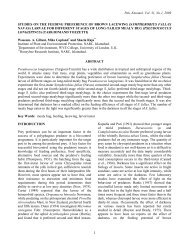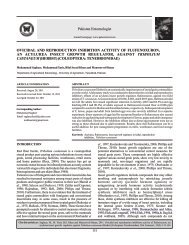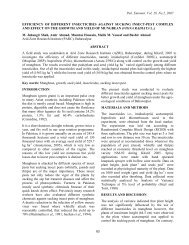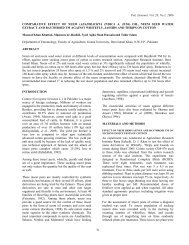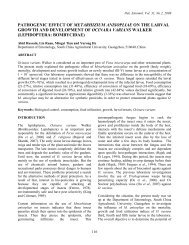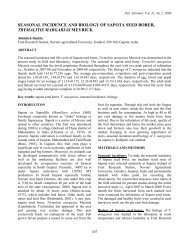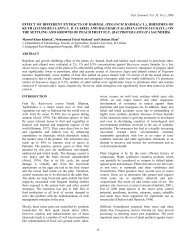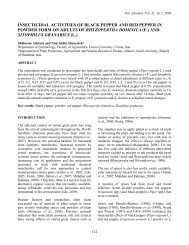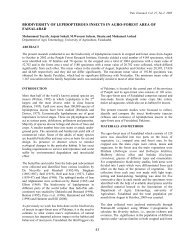efficacy of plant extracts against yellow rice stem borer, scirpophaga ...
efficacy of plant extracts against yellow rice stem borer, scirpophaga ...
efficacy of plant extracts against yellow rice stem borer, scirpophaga ...
Create successful ePaper yourself
Turn your PDF publications into a flip-book with our unique Google optimized e-Paper software.
Pak. Entomol. Vol. 29, No.1, 2007<br />
EFFICACY OF PLANT EXTRACTS AGAINST YELLOW RICE STEM BORER, SCIRPOPHAGA<br />
INCERTULAS (WALK.) IN RICE AT DOKRI, SINDH, PAKISTAN<br />
Abdul Rehman Dhuyo and N. M. Soomro<br />
Department <strong>of</strong> Zoology, University <strong>of</strong> Sindh, Jamshoro<br />
ABSTRACT<br />
A field experiment was conducted to determine the comparative <strong>efficacy</strong> <strong>of</strong> <strong>plant</strong> <strong>extracts</strong> (Azadirachta indica<br />
(Neem), Caloptropis sp. (Ak), Colocynth (Citrullus colocynthis) and tobacco <strong>extracts</strong>) which were sprayed on<br />
<strong>rice</strong> variety DR-58 (Dokri Rice 58) @ 40 ml / lit <strong>of</strong> water <strong>against</strong> <strong>yellow</strong> <strong>rice</strong> <strong>stem</strong> <strong>borer</strong>, Scirpophaga<br />
incertulas (Walk.) at Rice Research Institute, Dokri, Sindh, Pakistan, during the year Kharif 2006. Karate 2.5<br />
EC at 700 ml ha -1 was used as a reference chemical control. The effect <strong>of</strong> these sprayings was also recorded on<br />
predators and yield attributes. All the treatments including Karate plots had the comparable lowest number <strong>of</strong><br />
dead hearts, white heads, number <strong>of</strong> productive tillers and filled grains than un-treated control. Neem,<br />
Calotropis and Colocynth <strong>extracts</strong> produced comparable higher yield <strong>of</strong> 6,200 kg ha -1 , 6,000 kg ha -1 and 5,600<br />
kg ha -1 , respectively, than tobacco extract and Karate 2.5 EC, which produced 5,200 kg ha -1 and 5,280 kg ha -1<br />
respectively. Maximum number <strong>of</strong> different predators was found in neem extract treated plot. On the basis <strong>of</strong><br />
infestation <strong>of</strong> <strong>borer</strong>, high yield and conservation <strong>of</strong> predators, neem extract can be regarded as alternative <strong>of</strong><br />
the insecticides in <strong>rice</strong> pest management sy<strong>stem</strong>.<br />
Keywords: Rice, <strong>yellow</strong> <strong>stem</strong> <strong>borer</strong>, <strong>plant</strong> <strong>extracts</strong>, management, predators, yield<br />
INTRODUCTION<br />
Rice (Oryzae sativa L.) is one <strong>of</strong> the world’s most<br />
important crops providing a staple food for nearly<br />
half <strong>of</strong> the Global population (FAO, 2004), and for<br />
2.7 billion people in developing countries in Asia<br />
(FAO, 1995; PARC, 2003). Almost 90% <strong>of</strong> the <strong>rice</strong><br />
is grown and consumed in Asia (Khush and Brar,<br />
2002).<br />
The <strong>rice</strong> crop is subjected to sustain a considerable<br />
damage by a number <strong>of</strong> insect pests. Among them,<br />
the <strong>rice</strong> <strong>stem</strong> <strong>borer</strong>s are the principle devastators,<br />
which are responsible for economic crop losses<br />
under local conditions (Mahar and Hakro, 1979).<br />
Among the <strong>stem</strong> <strong>borer</strong>s, <strong>yellow</strong> <strong>rice</strong> <strong>stem</strong> <strong>borer</strong>,<br />
Scirpophaga incerulas (Walk.) is the most<br />
destructive insect pests <strong>of</strong> <strong>rice</strong> crop (Mahar et al.<br />
1985). Globally, Yellow <strong>rice</strong> <strong>stem</strong> <strong>borer</strong>alone causes<br />
yield losses <strong>of</strong> 10 million tones and accounts for<br />
50% <strong>of</strong> all insecticides used in the <strong>rice</strong> field<br />
(Huesing and English, 2004). This insect attacks the<br />
crop from the seedling stage to the harvesting stage<br />
and thus causes complete loss <strong>of</strong> affected tillers<br />
(Salim and Masih, 1987). Dead hearts are produced<br />
when the insect attacks at vegetative stage while<br />
white heads occur when the <strong>stem</strong> <strong>borer</strong> attack at time<br />
<strong>of</strong> heading (Mahmood-ur-Rehman, et al. 2007).<br />
Chemical insecticides are still major method to<br />
control insect pests particularly in the <strong>rice</strong> crop. The<br />
use <strong>of</strong> insecticides can be environmentally disruptive<br />
and can result in the accumulation <strong>of</strong> residues in the<br />
harvested produce (Chinniah et al. 1998). Dodan and<br />
Roshanlal (1999), Kaul and Sharma (1999), Rath<br />
(1999 and 2001), Bora et al. (2004) and Prasad et al.<br />
(2004) found neem products effective <strong>against</strong> <strong>yellow</strong><br />
<strong>rice</strong> <strong>stem</strong> <strong>borer</strong>. The application <strong>of</strong> 5% neem seed<br />
kernel extract on <strong>rice</strong> gave significant control <strong>of</strong><br />
<strong>yellow</strong> <strong>rice</strong> <strong>stem</strong> <strong>borer</strong> by reducing damage and<br />
increasing the yield (Amaugo and Emosairu, 2005).<br />
Keeping in view the importance <strong>of</strong> <strong>rice</strong> crop, the<br />
experiment was designed to determine relative<br />
<strong>efficacy</strong> <strong>of</strong> different <strong>plant</strong> <strong>extracts</strong> to control <strong>yellow</strong><br />
<strong>rice</strong> <strong>stem</strong> <strong>borer</strong>, the effect <strong>of</strong> these <strong>extracts</strong> on<br />
different predators and yield attributes.<br />
MATERIALS AND METHODS<br />
The experiment was conducted in the Experimental<br />
Area <strong>of</strong> Rice Research Institute, Dokri, Sindh,<br />
Pakistan, during the year Kharif 2006 in<br />
Randomized Complete Block Design (RCBD),<br />
having 6 treatments (T 1 = neem extract, T 2 =<br />
Caloptropis extract, T 3 = Colocynth extract, T 4 =<br />
tobacco extract, T 5 = Karate 2.5 EC and T 6 =<br />
23
Pak. Entomol. Vol. 29, No.1, 2007<br />
untreated (Control) which were repeated th<strong>rice</strong> in a<br />
net experimental area <strong>of</strong> 91 m 2 . Nursery <strong>of</strong> <strong>rice</strong><br />
variety DR-58 (Dokri Rice 58) was sown on 3 rd<br />
June, 2006 and line trans<strong>plant</strong>ing was done on 2 nd<br />
July, 2006 at 20 x 20 cm hill spacing. Plant <strong>extracts</strong><br />
were prepared in the following manner. Leaves and<br />
small branches <strong>of</strong> neem, leaves and flowers <strong>of</strong><br />
Calotropis and leaves <strong>of</strong> toabacco 5 Kg <strong>of</strong> each were<br />
cut into small pieces and mixed with 10 liter water.<br />
The mixture was boiled for 30-50 minutes and<br />
afterward was allowed to cool for about 2 hours and<br />
was then filtered through muslin cloth. Colocynth<br />
(Citrullus colocynthis) extract (3kg) was purchased<br />
from local market and mixed in 8 liters <strong>of</strong> water,<br />
which was boiled for 30-50 minutes, the mixture<br />
was allowed cool for about 2 hours and was then<br />
filtered through muslin cloth.<br />
All these <strong>plant</strong> <strong>extracts</strong> were sprayed on <strong>rice</strong> crop at<br />
vegetative growth stage (30 days after trans<strong>plant</strong>ing)<br />
@ 40 ml / liter <strong>of</strong> water. Karate 2.5 EC was used at a<br />
rate <strong>of</strong> 700 ml ha -1 .<br />
The collection and identification <strong>of</strong> predators <strong>of</strong><br />
<strong>yellow</strong> <strong>rice</strong> <strong>stem</strong> <strong>borer</strong> was started from 25 days<br />
after trans<strong>plant</strong>ing at 7 days interval, which was<br />
continued up to 100 days after trans<strong>plant</strong>ing to<br />
record the availability <strong>of</strong> predators. The predators<br />
were collected by net sweep method. The diameter<br />
<strong>of</strong> the net was 33.5 cm with 1.0 meter long handle.<br />
The collection was made in each treatment and<br />
replication for 25-30 minutes. The collected<br />
predators were kept separately, and identified in the<br />
laboratory.<br />
The pretreatment dead hearts (D.H) were counted 25<br />
days after trans<strong>plant</strong>ing. After 15 days <strong>of</strong> the spray,<br />
post-treatment dead hearts were counted. White<br />
Heads were noted at 70 days after trans<strong>plant</strong>ing. The<br />
dead hearts and white heads percentages were<br />
calculated using Abbott’s formula. Tiller count was<br />
determined from randomly selected 10 hills in each<br />
treatment and replication. Filled grain and unfilled<br />
grains were counted in laboratory on 10 selected<br />
panicles from each treatment and replication, the<br />
sterility percent was counted by total grains minus<br />
filled grains divided (/) total grains multiply (x) 100.<br />
The area <strong>of</strong> 5 x 5 m from each treatment and<br />
replication was harvested to obtain the paddy yield,<br />
which was extrapolated kg ha -1 . The data were<br />
averaged, tabulated and statistically analyzed using<br />
statistical program MSTAT.<br />
RESULTS AND DISCUSSION<br />
Pre-treatment dead heart count showed that 6.12 to<br />
8.44% tillers were damaged by <strong>yellow</strong> <strong>rice</strong> <strong>stem</strong><br />
<strong>borer</strong> (Table 1) which witnessed the availability <strong>of</strong><br />
<strong>yellow</strong> <strong>rice</strong> <strong>stem</strong> <strong>borer</strong> larvae in the experiment.<br />
After 15 days <strong>of</strong> the application <strong>of</strong> treatments, dead<br />
hearts count ranged from 2-3 % treated plots.<br />
Although, statistical analyses showed nonsignificant<br />
effect among treatments but control had<br />
significantly high dead heart percentage (9.10%)<br />
than in treated plots (P Colocynth extract (5600 kg ha -1 ) > Karate<br />
(5280 kg ha -1 ) > tobacco extract (5200 kg ha -1 ). The<br />
average increase paddy yield over the control ranged<br />
between 31.31 to 56.56 per cent in the respective<br />
treatments.<br />
24
Pak. Entomol. Vol. 29, No.1, 2007<br />
Table 1. Pre-and post-treatment dead hearts (%) and white heads (%) in <strong>rice</strong> variety DR- 58 in different<br />
Treatments<br />
Per- treatment Post-treatment D.H% W.H%<br />
D.H%<br />
Neem Derivatives 6.72 2.00b 3.20b<br />
Claptraps Derivatives 7.66 2.50b 3.10b<br />
Colocynth Derivatives 6.46 3.00b 3.90b<br />
Tobacco Derivatives 6.12 2.83b 4.50b<br />
Karate 2.5 EC 8.44 3.00b 3.10b<br />
Control 7.17 9.10a 10.12a<br />
Table 2. Paddy yield and yield attributing characters <strong>of</strong> <strong>rice</strong> variety DR-58 in different treatments<br />
Treatment<br />
Productive<br />
tillers<br />
Filled<br />
Grain<br />
Sterility % Yield<br />
(kg / ha)<br />
Neem Derivatives 32A 167 4.57 6200a<br />
Clap-trips Derivatives 31A 165 4.62 6000a<br />
Colocynth Derivatives 30A 155 5.49 5600a<br />
Tobacco Derivatives 31A 162 5.81 5200ab<br />
Karate 2.5 EC 32A 160 5.33 5280ab<br />
Control (Without insecticide) 27B 140 12.50 3960b<br />
Table 3. Population <strong>of</strong> different predators in <strong>rice</strong> variety DR-58 in different treatments<br />
Treatment<br />
Predator<br />
Carabid<br />
Beetle<br />
Cocccinellid<br />
Beetle<br />
Damsel<br />
Flies<br />
Dragon<br />
Flies<br />
Meadow Grass<br />
Hopper<br />
Neem Derivatives 3 5 12 25 2<br />
Clap-trips Derivatives 2 5 10 19 -<br />
Colocynth Derivatives - 3 5 8 -<br />
Tobacco Derivatives - 3 4 7 1<br />
Karate 2.5 EC - 1 2 4 -<br />
Control (Without insecticide) 4 5 12 27 1<br />
The results on the availability <strong>of</strong> predators in<br />
different treatments (Table 3) showed that almost<br />
same number <strong>of</strong> predators, was found in the<br />
treatment <strong>of</strong> neem extract and un-treated control<br />
(Carabid beetle 3 and 4, Coccinellid beetle 5,<br />
damselflies 12, dragonflies 25 and 27 and meadow<br />
grasshopper 2 and 1), respectively, which was higher<br />
than the number <strong>of</strong> predators available in other<br />
treatments. The least number <strong>of</strong> the predators were<br />
recorded in the treatment Karate 2.5 EC. Dragonflies<br />
and damselflies were abundant in the experimental<br />
area. The results indicated that the <strong>plant</strong> <strong>extracts</strong> had<br />
no adverse effect on predators than Karate.<br />
The preliminary results <strong>of</strong> this study reveals that<br />
since the plots treated with neem extract had the<br />
lowest dead hearts and white hearts percentage and<br />
produced maximum paddy yield than other<br />
treatments and more number <strong>of</strong> predators were also<br />
found in the neem extract. These results are in line<br />
with the findings <strong>of</strong> Dodan and Roshanlal (1999),<br />
Kaul and Sharma (1999), Rath (1999 and 2001),<br />
Bora et al. (2004) and Prasad et al. (2004) who<br />
found Neem products to control <strong>yellow</strong> <strong>rice</strong> <strong>stem</strong><br />
<strong>borer</strong>. Therefore, it is concluded that neem extract<br />
can be a suitable alternate <strong>of</strong> chemical pesticide to<br />
be sprayed on <strong>rice</strong> crop for controlling <strong>yellow</strong> <strong>rice</strong><br />
<strong>stem</strong> <strong>borer</strong> without disrupting agro-ecosy<strong>stem</strong>.<br />
25
Pak. Entomol. Vol. 29, No.1, 2007<br />
ACKNOWLEDGEMENT<br />
The authors are thankful Mr. Ahmed Nawaz Naich,<br />
Director, RRI, Dokri, Sindh, Pakistan and Dr. Gul<br />
Muhammad Baloch, Cotton Botanist, Agriculture<br />
Research Institute, Tandojam, Sindh, Pakistan for<br />
their valuable suggestions throughout the conduct <strong>of</strong><br />
this study.<br />
REFERENCES<br />
Amaugo , G.O and S.O. Emosairue, 2005. Effect <strong>of</strong><br />
neem seed kernel <strong>extracts</strong> on <strong>stem</strong> <strong>borer</strong><br />
damage and yield <strong>of</strong> upland <strong>rice</strong> in South<br />
Eastern Nigeria, IRRN 30. pp. 24.<br />
Bora,D.K., U. Bhuyan, G. Katti, I. C. Pasalu, 2004.<br />
Quantification <strong>of</strong> insect pest and natural enemy<br />
incidence vis a vis yield. Uttar Pradesh J. Zool.,<br />
24 (2): 187-190.<br />
Chinniah, C., S. Kuttalam and A. Regupaty, 1998.<br />
Harvest time residue <strong>of</strong> lindane and<br />
chlorpyriphos in paddy. Pestic. Res. J. 10 (1):<br />
91-94 .<br />
Dodan, D.S. and L. Roshan, 1999. Integrated<br />
management <strong>of</strong> neck blast and <strong>stem</strong> <strong>borer</strong> in<br />
scented <strong>rice</strong>. Haryana Agric. Univ. J. Res., 29<br />
(1/2): 47-49.<br />
Food and Agriculture Organization <strong>of</strong> the United<br />
Nations, 1995. FAO Quarterly Bulletin <strong>of</strong><br />
Statistics, 8: 1-2.<br />
Food and Agriculture Organization <strong>of</strong> the United<br />
Nations, 2004. The State <strong>of</strong> Food Security in<br />
the World, FAO, Rome, Italy. pp. 30-31.<br />
Huesing, J. and L. English, 2004. The impact <strong>of</strong> Bt.<br />
Crops on the developing world. Ag Bio Forum.<br />
7 (1-2): 84-95.<br />
Kaul, B.K. and P.K. Sharma, 1999. Efficacy <strong>of</strong> neem<br />
based insecticides <strong>against</strong> the major insect pests<br />
<strong>of</strong> <strong>rice</strong> in the hills <strong>of</strong> Himachal Pradesh (India).<br />
J. ento. Res., 23 (4): 377-379.<br />
Khush, G.S. and D.S. Brar, 2002. Biotechnology for<br />
<strong>rice</strong> breeding: Progress and potential impact.<br />
Proceed. 20 th Session Intern. Rice Comm. (23 rd -<br />
26 th July, Bangkok, Thailand). http:/www<br />
fao.org/docrep/006/Y475E/y 4751e04.htm.<br />
Mahar, M.M. and M.R. Hakro, 1979. The prospects<br />
and possibilities <strong>of</strong> Yellow <strong>rice</strong> <strong>stem</strong> <strong>borer</strong><br />
Eradication, under Sindh Condition. Paper<br />
presented at the Rice Research and Production<br />
Sem. Islamabad. 18-22 February.<br />
Mahar, M.M., I.M. Bhatti and A.R. Dhuyo, 1985.<br />
Stem <strong>borer</strong> infestation and yield loss<br />
relationship in <strong>rice</strong> and cost- benefits <strong>of</strong> control.<br />
Paper presented at 5 th National Sem. on Rice<br />
and Production. Kalashakaku, April 23-25, Pak.<br />
Mahmood-ur-Rehman , H. Rashid , A.A. Shahid, K.<br />
Bashir, T. Hussain and S. Riazuddin, 2007.<br />
Insect resistance and risk assessment studies <strong>of</strong><br />
advanced generation <strong>of</strong> Basmati Rice<br />
Expressing two genes <strong>of</strong> Bacillus thuringiensis.<br />
Electronic J. Biotechnol., 10 (2): 1-13.<br />
Pakistan Agriculture Research Council, 2003. Rice<br />
Production Hand Book. Balance fertilizer for<br />
maximizing economic crop yield. Islamabad.<br />
pp. 1-67.<br />
Prasad, S.S., P.K. Gupta, R.B. Singh, and B.L.<br />
Kanaujia, 2004. Evaluation <strong>of</strong> neem products<br />
was tested <strong>against</strong> <strong>yellow</strong> <strong>rice</strong> <strong>stem</strong> <strong>borer</strong>,<br />
Scirpopapha incertulas on deep water <strong>rice</strong>.<br />
Ann. Pl. Protect. Sci., 2: 426-428.<br />
Rath, P.C., 1999. Evaluation <strong>of</strong> some Bacillus<br />
huringiensis and neem formulations <strong>against</strong><br />
<strong>yellow</strong> <strong>stem</strong> <strong>borer</strong> <strong>of</strong> <strong>rice</strong> under rainfed<br />
lowlands. Oryza, 36: 398-399.<br />
Rath, P.C., 2001. Efficacy <strong>of</strong> insecticides, neem and<br />
Bt formulation <strong>against</strong> <strong>stem</strong> <strong>borer</strong> on <strong>rice</strong> yield<br />
in West Bengal. J. Appl. Zool. Res., 12: 191-93.<br />
Salim, M. and R. Masih, 1987. Efficacy <strong>of</strong><br />
insecticides <strong>against</strong> <strong>rice</strong> <strong>stem</strong> <strong>borer</strong> at NARC,<br />
Islamabad. Pak. J. Agric. Res., 8 (4): 477-479.<br />
26



